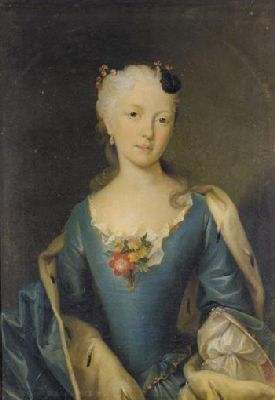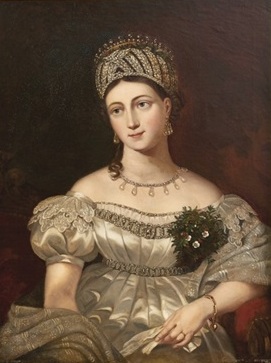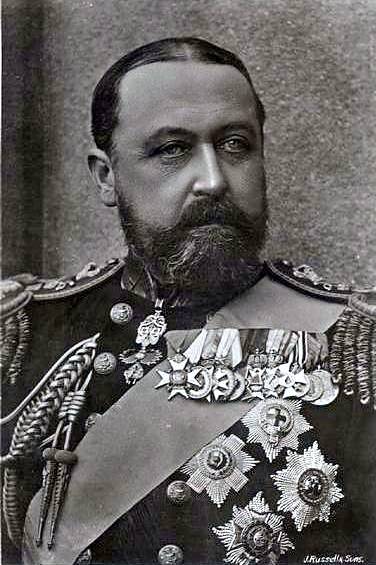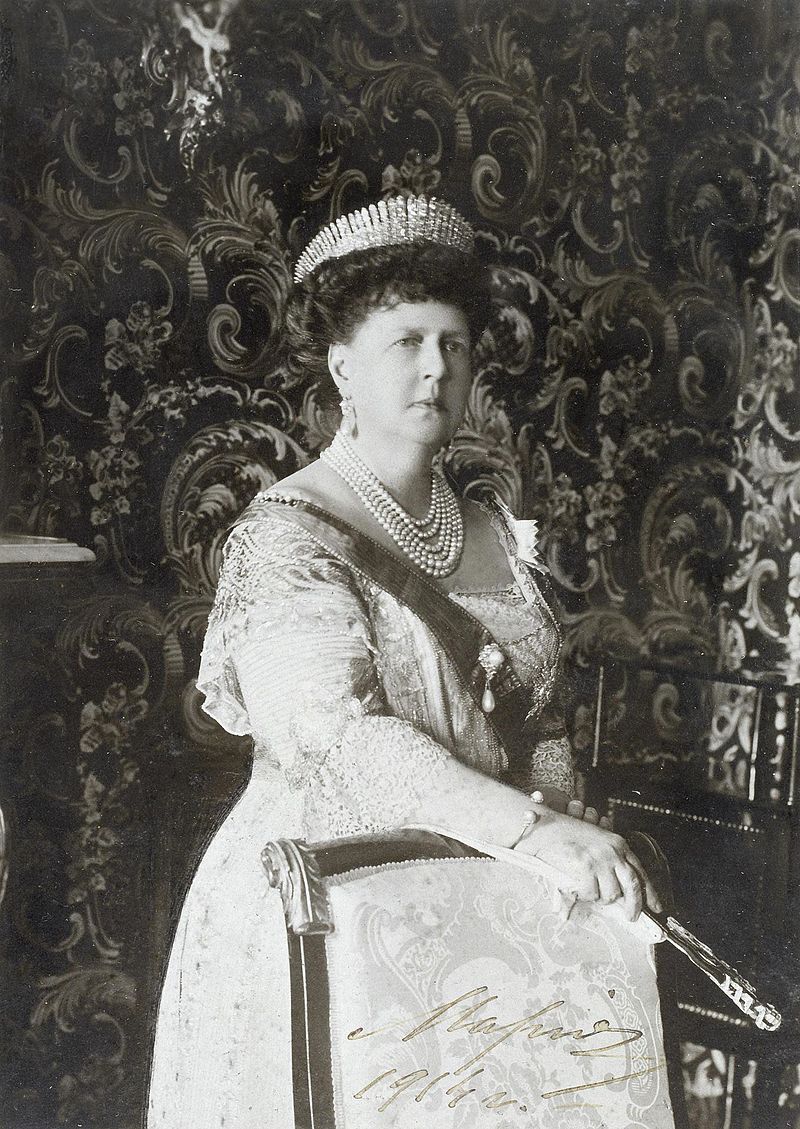by Scott Mehl and Susan Flantzer
© Unofficial Royalty 2017

Johanneskirche (Saalfeld); Credit – Von Kora27 – Eigenes Werk, CC BY-SA 4.0, https://commons.wikimedia.org/w/index.php?curid=94133516
Johanneskirche (St. John’s Church – link in German), an Evangelical Lutheran church, is on a hill in the old town section of Saalfeld, formerly in the Duchy of Saxe-Coburg-Saalfeld, now in the German state of Thuringia. After a previous Romanesque church burned down in 1314, today’s church was built between 1380 and 1514. When Saalfeld was the capital of the Duchy of Saxe-Saalfeld at the end of the 17th century, the crypt under the church served as the burial place of the ducal family.
In 1675, Ernst I, Duke of Saxe-Gotha-Altenburg died. Initially, his seven sons collectively governed the Duchy of Saxe-Gotha-Altenburg, as set out in their father’s will. In 1680, the seven brothers concluded a treaty of separation, with each brother getting a portion of the Duchy of Saxe-Gotha Altenburg and becoming a Duke. One of the seven new duchies was the Duchy of Saxe-Saalfeld and Johann Ernst, one of the seven sons of Ernst I, Duke of Saxe-Gotha-Altenburg became the first Duke of Saxe-Saalfeld. When two of his brothers died without male heirs, Johann Ernst took possession of Coburg (in 1699) and Römhild (in 1714). In 1699, Johann Ernst’s title changed to Duke of Saxe-Coburg-Saalfeld.

Coburg-Hofgarten-Mausoleum; Credit – “Coburg-Hofgarten-Mausoleum” von Störfix. Lizenziert unter CC BY-SA 3.0 über Wikimedia Commons – http://commons.wikimedia.org/wiki/File:Coburg-Hofgarten-Mausoleum.jpg#/media/File:Coburg-Hofgarten-Mausoleum.jpg
The Coburg Hofgarten (Coburg Court Garden – link in German) is a large landscape park in Coburg between the Coburg Palace Square, the forecourt to Ehrenburg Palace, and the Veste Coburg (Coburg Fortress), situated on a hill above the town of Coburg. Between 1816-1817, Ernst III, Duke of Saxe-Coburg-Saalfeld (later Ernst I, Duke of Saxe-Coburg and Gotha after another line became extinct and there was another split between three surviving duchies) had the Coburg-Hofgarten-Mausoleum (Coburg Court Garden Mausoleum) built for his parents Franz Friedrich Anton, Duke of Saxe-Coburg-Saalfeld and Augusta Reuss of Erbesdorf, Duchess of Saxe-Coburg-Saalfeld. The rectangular structure was built with sandstone masonry in the style of a Greek tomb. Two sphinxes guard the entrance.

The Morizkirche, Coburg. photo: by Störfix, CC BY-SA 3.0 de, https://commons.wikimedia.org/w/index.php?curid=14800843
Until 1860, the Morizkirche or Stadtkirche St. Moriz, an Evangelical Lutheran church, in Coburg, Duchy of Saxe-Coburg and Gotha, now in Bavaria, Germany, was the traditional burial site of the Saxe-Coburg families, with some tombs dating back to the 1500s. The royal crypt is located under the choir. A Romanesque basilica from the 12th-century stood in the place of the current church. The existing St. Moriz church dates from the 14th-century, which makes it Coburg’s oldest existing church. Construction began around 1310. Of course, these churches were Roman Catholic until the Reformation. The interior of the 14th-century church was refurbished in the Baroque style in the 18th century and most of what is visible today dates from that renovation. Renovations have continued over the years as needed.
Dukes of Saxe-Coburg-Saalfeld
- Johann Ernst IV – reigned August 6, 1699 – February 17, 1729
- Christian Ernst II – reigned February 17, 1729 – September 4, 1745
- Franz Josias – reigned September 4, 1745 – September 16, 1764
- Ernst Friedrich – reigned September 16, 1764 – September 8, 1800
- Franz Friedrich Anton – reigned September 8, 1800 – December 9, 1806
- Ernst III – reigned December 9, 1806 – November 12, 1826 as Duke of Saxe-Coburg-Saalfeld, reigned November 12, 1826 – January 29, 1844 as Ernst I, Duke of Saxe-Coburg and Gotha
Unofficial Royalty: Saxe-Coburg-Saalfeld/Saxe-Coburg and Gotha Index
All photos below are from Wikipedia unless otherwise noted.
* * * * * * * * *
Johann Ernst IV, Duke of Saxe-Coburg-Saalfeld

Johann Ernst IV was born on August 22, 1658, in Gotha, Duchy of Saxe-Gotha, now in Thuringia, Germany. He was the son of Ernst I, Duke of Saxe-Gotha and Elisabeth Sophie of Saxe-Altenburg. On February 18, 1680, Johann Ernst married Sophie Hedwig of Saxe-Merseburg and the couple had three children. Sophie Hedwig, aged 25, died in childbirth on August 2, 1686, after giving birth to a stillborn son. She was buried in the Johanneskirche in Saalfeld, Duchy of Saxe-Saalfeld, now in Thuringia, Germany.
Joann Ernst’s elder brothers Albrecht of Saxe-Coburg and Heinrich of Saxe-Römhild died without male heirs. Upon their deaths, Johann Ernest took possession of Coburg (in 1699) and Römhild (in 1714). In 1699, Johann Ernst became Duke of Saxe-Coburg-Saalfeld.

Charlotte Johanna of Waldeck-Wildungen
Four years after his first wife’s death, Johann Ernst married Charlotte Johanna of Waldeck-Wildungen on December 2, 1690. Johann Ernst and Charlotte Johanna had eight children. Johanna died on February 1, 1699, at the age of 34 and was buried in the Johanneskirche in Saalfeld, Duchy of Saxe-Saalfeld, now in Thuringia, Germany. Johann Ernst did not marry again. He died at Schloss Saalfeld on February 17, 1729, at the age of 70, and was buried with his two wives in the crypt at the Johanneskirche.
* * * * * * * * *
Christian Ernst II, Duke of Saxe-Coburg-Saalfeld

Born on August 18, 1683, Saalfeld, Duchy of Saxe-Saalfeld, now in the German state of Thuringia, Christian Ernst II, Duke of Saxe-Coburg-Saalfeld was the only son of Johann Ernst IV, Duke of Saxe-Coburg-Saalfeld and his first wife, Sophie Hedwig of Saxe-Merseburg.
Christian Ernst fell in love with Christiane von Koss, the daughter of Saalfeld forestry master. This relationship displeased both his father and his only surviving half-brother Franz Josias. Eventually, Christian Ernst’s father consented to the marriage, and the couple was married morganatically on August 18, 1724. A morganatic marriage meant that Christiane and any children from the marriage would not be entitled to her husband’s titles and privileges.
As the elder son, Christian Ernst was his father’s heir but because of his unequal marriage, his half-brother Franz Josias claimed the sole inheritance of the duchy. However, Johann Ernst decided that both his sons should reign jointly, and upon his death in 1729, his will forced the joint reign. On September 4, 1745, Christian Ernst died at Schloss Saalfeld at the age of 62. He was buried in the ducal crypt at the Johanneskirche in Saalfeld, Duchy of Saxe-Coburg-Saalfeld, now in Thuringia, Germany. Christian Ernst died childless and so his half-brother Franz Josias, who was fourteen years younger, became the sole Duke of Saxe-Coburg-Saalfeld.
* * * * * * * * *
Franz Josias, Duke of Saxe-Coburg-Saalfeld

Franz Josias, Duke of Saxe-Coburg-Saalfeld was born September 25, 1697, in Saalfeld, Duchy of Saxe-Saalfeld, now in the German state of Thuringia. He was the of Johann Ernst IV, Duke of Saxe-Coburg-Saalfeld and his second wife Charlotte Johanna of Waldeck-Wildungen. Franz Josias married Anna Sophie of Schwarzburg-Rudolstadt on January 2, 1723 and they had eight children.
Franz Josias, Duke of Saxe-Coburg-Saalfeld died on September 16, 1764, aged 66, at Schloss Rodach in Rodach, Duchy of Saxe-Coburg-Saalfeld. He was buried in the ducal crypt at the Morizkirche in Coburg, Duchy of Saxe-Coburg-Saalfeld, now in Bavaria, Germany. His wife Anna Sophie survived him by sixteen years, dying on December 11, 1780, at the age of 80. She was buried with her husband at the Morizkirche in Coburg.
* * * * * * * * *
Ernst Friedrich, Duke of Saxe-Coburg-Saalfeld

Ernst Friedrich, Duke of Saxe-Coburg-Saalfeld, was born on March 8, 1724, in Saalfeld, Duchy of Saxe-Coburg-Saalfeld, now in Thuringia, Germany. Ernst Friedrich was the son of Franz Josias, Duke of Saxe-Coburg-Saalfeld and Anna Sophie of Schwarzburg-Rudolstadt. On April 23, 1749, Ernst Friedrich married Sophia Antonia of Brunswick-Wolfenbüttel. They had seven children but only three survived childhood. Ernst Friedrich and Sophia Antonia are the great-grandparents of Queen Victoria and her husband Prince Albert.

Sophia Antonia of Brunswick-Wolfenbüttel
In 1764, Ernst Friedrich succeeded his father as Duke of Saxe-Coburg-Saalfeld and transferred the official residence of the duchy from Saalfeld to Coburg. Ernst Friedrich, Duke of Saxe-Coburg-Saalfeld died on September 8, 1800 in Coburg, Duchy of Saxe-Coburg-Saalfeld at the age of 76. He was buried in the ducal crypt at the Morizkirche in Coburg, Duchy of Saxe-Coburg-Saalfeld, now in Bavaria, Germany. His wife Sophia Antonia survived him by almost two years, dying on May 17, 1802, at the age of 78. She was buried with her husband.
- Unofficial Royalty: Ernst Friedrich, Duke of Saxe-Coburg-Saalfeld
- Unofficial Royalty: Sophia Antonia of Brunswick-Wolfenbüttel, Duchess of Saxe-Coburg-Saalfeld
* * * * * * * * *
Franz Friedrich Anton, Duke of Saxe-Coburg-Saalfeld

On July 15, 1750, Franz Frederick Anton, Duke of Saxe-Coburg-Saalfeld was born in Coburg, Duchy of Saxe-Coburg-Saalfeld, now a town in Bavaria, Germany. He was the son of Ernst Friedrich, Duke of Saxe-Coburg-Saalfeld and his wife Sophia Antonia of Brunswick-Wolfenbüttel.
On March 6, 1775, Franz married Sophie of Saxe-Hildburghausen. At the time, Franz was already in love with his future wife, Augusta Reuss of Ebersdorf, but he was unable to break off his engagement with Sophie. The bride was only 16 years old and died of influenza just six months after the wedding which allowed Franz to marry his beloved Augusta. On June 13, 1777, Franz married Augusta Reuss of Ebersdorf. They had nine children including Ernst I, Duke of Saxe-Coburg-Gotha (the father of Prince Albert), Prince Ferdinand of Saxe-Coburg and Gotha (the father of Ferdinand, King Consort of Portugal and the grandfather of Tsar Ferdinand I of Bulgaria), Princess Victoria of Saxe-Coburg-Saalfeld (the mother of Queen Victoria) and Prince Leopold of Saxe-Coburg and Gotha (the future Leopold I, King of the Belgians).
Franz Frederick Anton died on December 9, 1806, in Coburg, Duchy of Saxe-Coburg-Saalfeld, now in Bavaria, Germany at the age of 56. He was buried in the Coburg-Hofgarten-Mausoleum in the Coburg Hofgarten (Coburg Court Garden), a large landscape park in Coburg.
Augusta Reuss of Erbesdorf, Duchess of Saxe-Coburg-Saalfeld

Augusta Reuss of Ebersdorf on January 19, 1757, in Ebersdorf Castle, in Ebersdorf, County of Reuss-Ebersdorf, now in Thuringia, Germany. She was the daughter of Heinrich XXIV, Count Reuss of Ebersdorf and Karoline Ernestine of Erbach-Schönberg. With her husband Franz Friedrich Anton, Duke of Saxe-Coburg-Saalfeld, Augusta had nine children.
Augusta may have been the first person to suggest a marriage between two of her grandchildren. In 1821, in a letter to her daughter Victoria, Duchess of Kent, she suggested the possibility of marriage between Victoria’s daughter, the future Queen Victoria, and Albert, the second son of her son Ernst I, Duke of Saxe-Coburg and Gotha. Victoria and Albert were only two years old at the time.
Augusta did not live long enough to see her grandchildren Victoria and Albert marry. She died in Coburg, Duchy of Saxe-Coburg-Saalfeld now in Bavaria, Germany at the age of 74 on November 16, 1831, five months after the election of her son Leopold as King of the Belgians. She was buried with her husband in the Coburg-Hofgarten-Mausoleum in the Coburg Court Garden.
* * * * * * * * *
Burial Sites of the Duchy of Saxe-Coburg and Gotha

The Ducal Mausoleum in the Glockenberg Cemetery. photo: by Störfix – Selbst fotografiert, CC BY-SA 3.0, https://commons.wikimedia.org/w/index.php?curid=4010189
By the mid-1800s, there was no space for further burials in the Morizkirche in Coburg, Duchy of Saxe-Coburg and Gotha, now in Bavaria, Germany, so Ernst II, Duke of Saxe-Coburg and Gotha commissioned a mausoleum in the newly established Glockenberg Cemetery (link in German), also in Coburg, to serve as the burial site for the ducal family of Saxe-Coburg and Gotha. Construction began in 1853, with financial support from the royal houses of Belgium and the United Kingdom, both having connections to the House of Saxe-Coburg and Gotha. The Ducal Mausoleum (link in German) was dedicated in November 1860, and the remains of Ernst I and his first wife were moved there from the Morizkirche.
The following family members are buried in the Ducal Mausoleum. See information for the Dukes and Duchesses below.
Ground floor, north corridor:
- Ernst I, Duke of Saxe-Coburg and Gotha (1784–1844)
- Luise of Saxe-Gotha-Altenburg, Duchess of Saxe-Coburg-Saalfeld (1800–1831), first wife of Ernst I
- Marie of Württemberg, Duchess of Saxe-Coburg and Gotha (1799–1860), second wife of Ernst I
- Ernst II, Duke of Saxe-Coburg and Gotha (1818-1893)
- Alexandrine of Baden, Duchess of Saxe-Coburg and Gotha (1820–1904), wife of Ernst II
- Prince Ferdinand of Saxe-Coburg and Gotha (1785-1851), son of Franz Friedrich Anton, Duke of Saxe-Coburg-Saalfeld
- Maria Antonia Koháry. Princess of Saxe-Coburg and Gotha (1797-1862), wife of Prince Ferdinand
- Prince Leopold of Saxe-Coburg and Gotha (1824-1884), son of Prince Ferdinand
Ground floor, south corridor:
- Alfred, Duke of Saxe-Coburg and Gotha (1844–1900), son of Queen Victoria of the United Kingdom and Prince Albert of Saxe-Coburg and Gotha
- Grand Duchess Maria Alexandrovna of Russia, Duchess of Saxe-Coburg and Gotha (1853–1920), wife of Alfred
- Hereditary Prince Alfred of Saxe-Coburg and Gotha (1874–1899), son of Alfred
Upper floor:
- Prince Ernst Alexander Konstantin of Württemberg (1807–1868), brother of Marie of Württemberg, Duchess of Saxe-Coburg and Gotha

The cemetery at Schloss Callenberg; Photo Credit – Wikipedia
Charles Edward, the last Duke of Saxe-Coburg and Gotha, died in 1954, nearly 36 years after the monarchy was abolished. He and his wife are buried in the Waldfriedhof (Forest Cemetery) on the grounds of Schloss Callenberg in Coburg, Bavaria, Germany. At the end of World War II, American forces occupied Schloss Callenberg. Subsequently, it was rented by a theater company and served as a retirement home. In 1957, a technical college moved into the castle. The ducal family sold the property in 1972. In 1982, Prince Andreas, Charles Edward’s grandson and Head of the House of Saxe-Coburg and Gotha, was able to buy back Schloss Callenberg through the Ducal Family Foundation.
The following family members are buried in the Waldfriedhof (Forest Cemetery) on the grounds of Schloss Callenberg:
- Charles Edward, Duke of Saxe-Coburg and Gotha (1884-1954)
- Viktoria Adelheid of Schleswig-Holstein-Sonderburg-Glücksburg, Duchess of Saxe-Coburg and Gotha (1885-1970), wife of Charles Edward
- Prince Hubertus of Saxe-Coburg and Gotha (1909-1943), son of Charles Edward, killed during World War II
- Princess Caroline Mathilde of Saxe-Coburg and Gotha (1912-1983), daughter of Charles Edward
- Friedrich Josias, Prince of Saxe-Coburg and Gotha (1918-1998), son of Charles Edward
- Princess Claudia, Mrs. Schäfer (1949-2016), daughter of Friedrich Josias
- Katrin Bremme (1940-2011), third wife of Friedrich Josias
Dukes of Saxe-Coburg and Gotha
- Ernst I – reigned November 12, 1826 – January 29, 1844
- Ernst II – reigned January 29, 1844 – August 22, 1893
- Alfred – reigned August 22, 1893 – July 30, 1900
- Charles Edward – reigned July 30, 1900 – November 14, 1918
Unofficial Royalty: Saxe-Coburg-Saalfeld/Saxe-Coburg and Gotha Index
All photos below are from Wikipedia unless otherwise noted.
* * * * * * * * *
Ernst I
Duke of Saxe-Coburg-Saalfeld (1806 – 1826)
Duke of Saxe-Coburg and Gotha (1826 – 1844)

Ernst I was born in Coburg on January 2, 1784, the eldest son of Franz, Duke of Saxe-Coburg-Saalfeld and Countess Augusta of Reuss-Ebersdorf. His siblings included the future King Leopold I of the Belgians and Princess Victoire, Duchess of Kent, mother of Queen Victoria. He became Duke of Saxe-Coburg-Saalfeld upon his father’s death in 1806, as Ernst III. In July 1817, he married Luise of Saxe-Gotha-Altenburg and had two sons – Ernst II, Duke of Saxe-Coburg and Gotha and Prince Albert, husband of Queen Victoria – before divorcing in 1826. That same year, following the reorganization of the Saxon duchies, Ernst became Duke Ernst I of Saxe-Coburg and Gotha. In 1832, he married his niece Marie of Württemberg. Ernst I died in Gotha, Duchy of Saxe-Coburg and Gotha, now in Thuringia, Germany on January 29, 1844, and was buried in the Morizkirche. In 1860, his remains were moved to the Ducal Mausoleum in the Glockenberg Cemetery.
Princess Luise of Saxe-Gotha-Altenburg,
Duchess of Saxe-Coburg-Saalfeld
1st wife of Ernst I

Luise was born in Gotha on December 21, 1800, the daughter of August, Duke of Saxe-Gotha-Altenburg and Duchess Luise Charlotte of Mecklenburg-Schwerin. On July 31, 1817, she married Ernst I, then the Duke of Saxe-Coburg-Saalfeld. They had two sons – Ernst II (1818) and Albert (1819). Luise separated from her husband in 1824 and moved to St. Wendel in Lichtenberg, forced to leave her sons behind. The couple divorced on March 31, 1826, and several months later, Luise married in secret to Baron Alexander von Hanstein. She died in Paris from cervical cancer on August 30, 1831. Louise’s embalmed body had been kept at the Schlösschen (Little Palace) in St. Wendel, but then, as a result of intrigues within the House of Saxe-Coburg, it somehow disappeared. First, the coffin found its way to a legal assistant’s house, and then in 1833 to the church in the village of Pfeffelbach in the Principality of Lichtenberg, where it lay in a simple crypt under the pulpit and was almost forgotten. On June 9, 1846, Louise’s coffin was taken to Coburg, where it stayed at the Morizkirche, before being moved to the Ducal Mausoleum in Glockenberg Cemetery in 1860.
Duchess Marie of Württemberg
Duchess of Saxe-Coburg and Gotha
2nd wife of Ernst I
Marie was born on September 17, 1799, in Coburg, the daughter of Duke Alexander of Württemberg and Princess Antoinette of Saxe-Coburg-Saalfeld. She married Ernst I – her maternal uncle – on December 23, 1832, becoming stepmother to her two cousins, Ernst and Albert. She survived her husband by sixteen years, dying at Schloss Friedenstein in Gotha, Duchy of Saxe-Coburg and Gotha, now in Thuringia, Germany on September 24, 1860. She is buried in the Ducal Mausoleum in the Glockenberg Cemetery.
* * * * * * * * *
Ernst II, Duke of Saxe-Coburg and Gotha

Ernst II was born at Ehrenburg Palace on Coburg on June 21, 1818, the elder son of Ernst I, then Duke of Saxe-Coburg-Saalfeld, and Princess Luise of Saxe-Coburg-Altenburg. On May 3, 1842, he married Princess Alexandrine of Baden. They had no children. He became reigning Duke of Saxe-Coburg and Gotha upon his father’s death in 1844. He died on August 22, 1893, at Reinhardsbrunn Castle in Gotha, Duchy of Saxe-Coburg and Gotha, now in Thuringia, Germany. Following his funeral at the Morizkirche, he was buried in the Ducal Mausoleum in the Glockenberg Cemetery.
Princess Alexandrine of Baden
Duchess of Saxe-Coburg and Gotha

Princess Alexandrine of Baden was born in Karlsruhe on December 6, 1820, the daughter of Leopold, Grand Duke of Baden, and Princess Sophie of Sweden. She married Ernst II on May 3, 1842, but had no children. Alexandrine died at Schloss Callenberg in Coburg, Duchy of Saxe-Coburg and Gotha, now in Bavaria, Germany on December 20, 1904, and is buried beside her husband in the Ducal Mausoleum in the Glockenberg Cemetery.
* * * * * * * * * *
Alfred, Duke of Saxe-Coburg and Gotha

Prince Alfred of the United Kingdom was born on August 6, 1844, at Windsor Castle, the second son of Queen Victoria of the United Kingdom and Prince Albert of Saxe-Coburg and Gotha. Alfred served for most of his life in the Royal Navy, becoming a distinguished officer. He was created Duke of Edinburgh in May 1866. On January 23, 1874, he married Grand Duchess Maria Alexandrovna of Russia and they had five children. By the mid-1860s, it was already expected that Alfred would inherit the throne of Saxe-Coburg and Gotha. His older brother – the future King Edward VII of the United Kingdom – had relinquished his rights, making Alfred the heir to his childless uncle, Ernst II. Upon Ernst’s death in 1893, Alfred became the Duke of Saxe-Coburg and Gotha and ruled for nearly seven years before dying of throat cancer at Schloss Rosenau in Coburg, Duchy of Saxe-Coburg and Gotha, now in Bavaria, Germany, on July 30, 1900. He is buried in the Ducal Mausoleum in the Glockenburg Cemetery.
Grand Duchess Maria Alexandrovna of Russia
Duchess of Saxe-Coburg and Gotha
Grand Duchess Maria Alexandrovna was born at the Alexander Palace in Tsarskoye Selo, Russia, on October 17, 1853, the only daughter of Alexander II, Emperor of All Russia and Princess Marie of Hesse and by Rhine. She married Prince Alfred, Duke of Edinburgh on January 23, 1874, and had five children. After her husband’s death in 1900, she remained in Coburg until the outbreak of World War I, retiring to her villa in Tegernsee, Bavaria, and then settling permanently in Switzerland. The Dowager Duchess died in Zurich, Switzerland on October 25, 1920. She is buried beside her husband in the Ducal Mausoleum in the Glockenburg Cemetery.
* * * * * * * * * *
Charles Edward, Duke of Saxe-Coburg and Gotha

Charles Edward was born a British prince, Prince Charles Edward of Albany on July 19, 1884, at Claremont House in Surrey, England, the son of the late Prince Leopold, Duke of Albany and Princess Helena of Waldeck and Pyrmont, and a grandson of Queen Victoria and Prince Albert of Saxe-Coburg and Gotha. In 1900, he became Duke of Saxe-Coburg and Gotha upon the death of his uncle Alfred. In October 1905, he married Princess Viktoria Adelheid of Schleswig-Holstein-Sonderburg-Glücksburg, and they had five children. Charles Edward was deposed on November 9, 1918, but retained several of his properties and received significant financial compensation for lost properties and possessions. A supporter of Adolf Hitler, Charles Edward was imprisoned after World War II and charged with crimes against humanity. The charges were later reduced and he paid a large fine which left him bankrupt. The former Duke of Saxe-Coburg and Gotha died in his apartment on Elsässer Straße (Street) in Coburg, Bavaria, Germany on March 6, 1954, and is buried in the Waldfriedhof (Forest Cemetery) at Schloss Callenberg.
Princess Viktoria Adelheid of
Schleswig-Holstein-Sonderburg-Glücksburg
Duchess of Saxe-Coburg and Gotha

Victoria Adelheid was born in Grünholz, Schleswig-Holstein on December 31, 1885. She married Charles Edward, Duke of Saxe-Coburg and Gotha in October 1905 and had five children. She survived her husband by 16 years, dying at Schloss Greinburg in Austria on October 3, 1970. She is buried beside her husband in the Waldfriedhof (Forest Cemetery) at Schloss Callenberg.
* * * * * * * * *
This article is the intellectual property of Unofficial Royalty and is NOT TO BE COPIED, EDITED, OR POSTED IN ANY FORM ON ANOTHER WEBSITE under any circumstances. It is permissible to use a link that directs to Unofficial Royalty.



